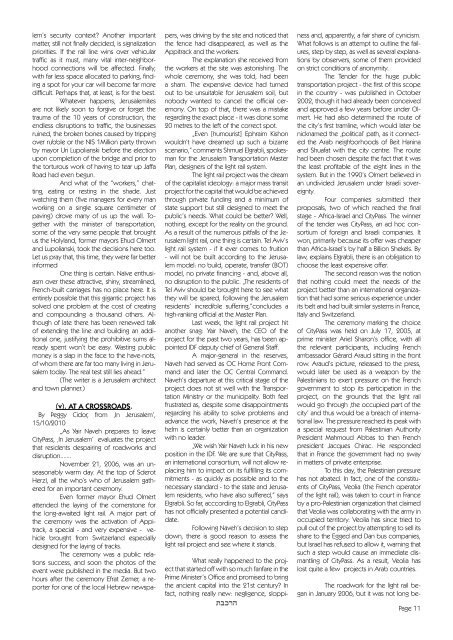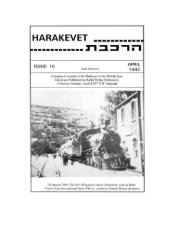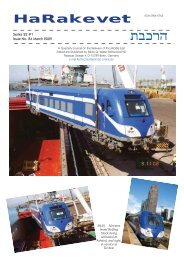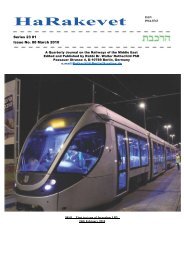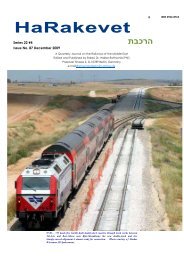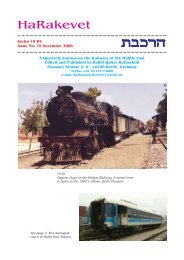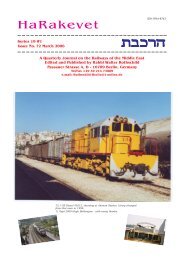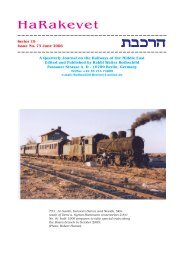Create successful ePaper yourself
Turn your PDF publications into a flip-book with our unique Google optimized e-Paper software.
lem’s security context? Another important<br />
matter, still not finally decided, is signalization<br />
priorities. If the rail line wins over vehicular<br />
traffic as it must, many vital inter-neighborhood<br />
connections will be affected. Finally,<br />
with far less space allocated to parking, finding<br />
a spot for your car will become far more<br />
difficult. Perhaps that, at least, is for the best.<br />
Whatever happens, Jerusalemites<br />
are not likely soon to forgive or forget the<br />
trauma of the 10 years of construction, the<br />
endless disruptions to traffic, the businesses<br />
ruined, the broken bones caused by tripping<br />
over rubble or the NIS 1Million party thrown<br />
by mayor Uri Lupolianski before the election<br />
upon completion of the bridge and prior to<br />
the torturous work of having to tear up Jaffa<br />
Road had even begun.<br />
And what of the “workers,” chatting,<br />
eating or resting in the shade. Just<br />
watching them (five managers for every man<br />
working on a single square centimeter of<br />
paving) drove many of us up the wall. Together<br />
with the minister of transportation,<br />
some of the very same people that brought<br />
us the Holyland, former mayors Ehud Olmert<br />
and Lupolianski, took the decisions here too.<br />
Let us pray that, this time, they were far better<br />
informed<br />
One thing is certain. Naïve enthusiasm<br />
over these attractive, shiny, streamlined,<br />
French-built carriages has no place here. It is<br />
entirely possible that this gigantic project has<br />
solved one problem at the cost of creating<br />
and compounding a thousand others. Although<br />
of late there has been renewed talk<br />
of extending the line and building an additional<br />
one, justifying the prohibitive sums already<br />
spent won’t be easy. Wasting public<br />
money is a slap in the face to the have-nots,<br />
of whom there are far too many living in Jerusalem<br />
today. The real test still lies ahead.“<br />
(The writer is a Jerusalem architect<br />
and town planner.)<br />
The roadwork for the light rail began<br />
in January 2006, but it was not long bepers,<br />
was driving by the site and noticed that<br />
the fence had disappeared, as well as the<br />
Appitrack and the workers.<br />
The explanation she received from<br />
the workers at the site was astonishing. The<br />
whole ceremony, she was told, had been<br />
a sham. The expensive device had turned<br />
out to be unsuitable for Jerusalem soil, but<br />
nobody wanted to cancel the official ceremony.<br />
On top of that, there was a mistake<br />
regarding the exact place - it was done some<br />
20 metres to the left of the correct spot.<br />
„Even [humourist] Ephraim Kishon<br />
wouldn‘t have dreamed up such a bizarre<br />
scenario,“ comments Shmuel Elgrabli, spokesman<br />
for the Jerusalem Transportation Master<br />
Plan, designers of the light rail system.<br />
The light rail project was the dream<br />
of the capitalist ideology: a major mass transit<br />
project for the capital that would be achieved<br />
through private funding and a minimum of<br />
state support but still designed to meet the<br />
public‘s needs. What could be better? Well,<br />
nothing, except for the reality on the ground.<br />
As a result of the numerous pitfalls of the Jerusalem<br />
light rail, one thing is certain. Tel Aviv‘s<br />
light rail system - if it ever comes to fruition<br />
- will not be built according to the Jerusalem<br />
model: no build, operate, transfer (BOT)<br />
model, no private financing - and, above all,<br />
no disruption to the public. „The residents of<br />
Tel Aviv should be brought here to see what<br />
they will be spared, following the Jerusalem<br />
residents‘ incredible suffering,“concludes a<br />
high-ranking official at the Master Plan.<br />
Last week, the light rail project hit<br />
another snag: Yair Naveh, the CEO of the<br />
project for the past two years, has been appointed<br />
IDF deputy chief of General Staff.<br />
A major-general in the reserves,<br />
Naveh had served as OC Home Front Command<br />
and later the OC Central Command.<br />
Naveh‘s departure at this critical stage of the<br />
project does not sit well with the Transportation<br />
Ministry or the municipality. Both feel<br />
frustrated as, despite some disappointments<br />
regarding his ability to solve problems and<br />
advance the work, Naveh‘s presence at the<br />
helm is certainly better than an organization<br />
with no leader.<br />
„We wish Yair Naveh luck in his new<br />
position in the IDF. We are sure that CityPass,<br />
an international consortium, will not allow replacing<br />
him to impact on its fulfilling its commitments<br />
- as quickly as possible and to the<br />
necessary standard - to the state and Jerusalem<br />
residents, who have also suffered,“ says<br />
Elgrabli. So far, acccording to Elgrabli, CityPass<br />
has not officially presented a potential candidate.<br />
Following Naveh‘s decision to step<br />
down, there is good reason to assess the<br />
light rail project and see where it stands.<br />
What really happened to the project<br />
that started off with so much fanfare in the<br />
Prime Minister‘s Office and promised to bring<br />
the ancient capital into the 21st century? In<br />
fact, nothing really new: negligence, sloppi-<br />
,cfrv<br />
(v). AT A CROSSROADS.<br />
By Peggy Cidor, from ‚In Jerusalem‘,<br />
15/10/2010<br />
„As Yair Naveh prepares to leave<br />
CityPass, ‚In Jerusalem‘ evaluates the project<br />
that residents despairing of roadworks and<br />
disruption.......<br />
November 21, 2006, was an unseasonably<br />
warm day. At the top of Sderot<br />
Herzl, all the who‘s who of Jerusalem gathered<br />
for an important ceremony.<br />
Even former mayor Ehud Olmert<br />
attended the laying of the cornerstone for<br />
the long-awaited light rail. A major part of<br />
the ceremony was the activation of Appitrack,<br />
a special - and very expensive - vehicle<br />
brought from Switzerland especially<br />
designed for the laying of tracks.<br />
The ceremony was a public relations<br />
success, and soon the photos of the<br />
event were published in the media. But two<br />
hours after the ceremony Efrat Zemer, a reporter<br />
for one of the local Hebrew newspaness<br />
and, apparently, a fair share of cynicism.<br />
What follows is an attempt to outline the failures,<br />
step by step, as well as several explanations<br />
by observers, some of them provided<br />
on strict conditions of anonymity.<br />
The Tender for the huge public<br />
transportation project - the first of this scope<br />
in the country - was published in October<br />
2002, though it had already been conceived<br />
and approved a few years before under Olmert.<br />
He had also determined the route of<br />
the city‘s first tramline, which would later be<br />
nicknamed the ‚political‘ path, as it connected<br />
the Arab neighborhoods of Beit Hanina<br />
and Shuafat with the city centre. The route<br />
had been chosen despite the fact that it was<br />
the least profitable of the eight lines in the<br />
system. But in the 1990‘s Olmert believed in<br />
an undivided Jerusalem under Israeli sovereignty.<br />
Four companies submitted their<br />
proposals, two of which reached the final<br />
stage - Africa-Israel and CityPass. The winner<br />
of the tender was CityPass, an ad hoc consortium<br />
of foreign and Israeli companies. It<br />
won, primarily because its offer was cheaper<br />
than Africa-Israel‘s by half a Billion Shekels. By<br />
law, explains Elgrabli, there is an obligation to<br />
choose the least expensive offer.<br />
The second reason was the notion<br />
that nothing could meet the needs of the<br />
project better than an international organization<br />
that had some serious experience under<br />
its belt and had built similar systems in France,<br />
Italy and Switzerland.<br />
The ceremony marking the choice<br />
of CityPass was held on July 17, 2005, at<br />
prime minister Ariel Sharon‘s office, with all<br />
the relevant participants, including French<br />
ambassador Gérard Araud sitting in the front<br />
row. Araud‘s picture, released to the press,<br />
would later be used as a weapon by the<br />
Palestinians to exert pressure on the French<br />
government to stop its participation in the<br />
project, on the grounds that the light rail<br />
would go through ‚the occupied part of the<br />
city‘ and thus would be a breach of international<br />
law. The pressure reached its peak with<br />
a special request from Palestinian Authority<br />
President Mahmoud Abbas to then French<br />
president Jacques Chirac. He responded<br />
that in France the government had no sway<br />
in matters of private enterprise.<br />
To this day, the Palestinian pressure<br />
has not abated. In fact, one of the constituents<br />
of CityPass, Veolia (the French operator<br />
of the light rail), was taken to court in France<br />
by a pro-Palestinian organization that claimed<br />
that Veolia was collaborating with the army in<br />
occupied territory. Veolia has since tried to<br />
pull out of the project by attempting to sell its<br />
share to the Egged and Dan bus companies,<br />
but Israel has refused to allow it, warning that<br />
such a step would cause an immediate dismantling<br />
of CityPass. As a result, Veolia has<br />
lost quite a few projects in Arab countries.<br />
Page 11


